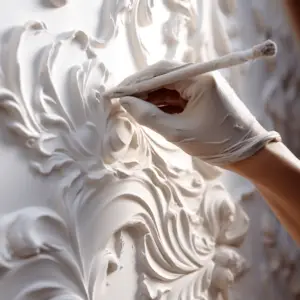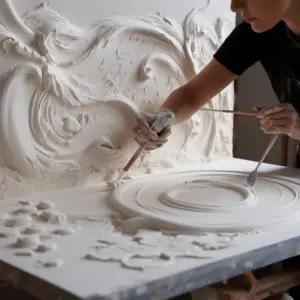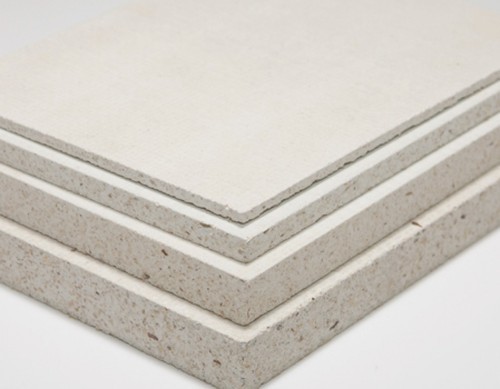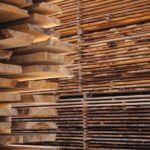Plaster of Paris is a quick and easy way to drywall a small hole or crack in a wall, but does it hold up better than regular plaster? Here’s our comparison of the two to find out for yourself.
Table of Contents
What is Plaster of Paris?

Plaster of Paris is a building product made by mixing fine white powder (calcium sulfate) and water. When combined, the calcium sulfate forms a strong bond. This bond creates a very durable substance called gypsum, which goes on to harden. The resulting hardened plaster can be used in various ways.
Once dried, it can be painted or otherwise decorated.
What is Plaster?
Plaster is a general term that refers to any material that is applied directly to the surface of an object or wall and then allowed to dry. It can be made from lime, gypsum, or cement, but most commonly, it refers to gypsum plaster.
Plaster of Paris vs Plaster: What is the difference?
Plaster and plaster of Paris are similar building materials used for coating walls and giving shape to moldable objects. However, they differ in terms of the materials used to make them, their applications, and their physical properties.
Differences in Materials Used
Plaster is made by adding water to lime or gypsum, whereas plaster of Paris is made by heating gypsum.
Differences in Applications
The main difference between plaster and plaster of Paris lies in the way they are used. Plaster of Paris is mainly used to create molds and casts, whereas plaster is used as a coating material where it covers the surface of walls and ceilings. Plaster also has other uses, such as in fresco paintings and as a surgical dressing.
Differences in Physical Properties
The main difference between plaster and plaster of Paris is that the latter sets faster than the former. When mixed with water, both materials form a paste; however, this paste hardens at different speeds. Plaster takes about 24 hours to dry completely; on the other hand, plaster of Paris takes about 20 minutes to dry completely.
Plaster of Paris has many advantages over regular plaster:
It’s extremely cheap: Plaster of Paris costs less than $1 per square foot. That’s as cheap as you can get without actually buying dirt.
It dries quickly: If setting time is crucial to your project (for example, if you’re patching a wall or ceiling before painting it) and you simply can’t wait for regular plaster to dry, Plaster of Paris will save the day. It sets in 20 minutes or so, and you can paint over it within about an hour.
It’s easy to use: Mixing the powder with water is a quick and easy process that requires no special skills or equipment. Even a novice homeowner can do it without getting into trouble.
It doesn’t crack easily. If regular plaster cracks, it tends to crumble apart. If Plaster of Paris cracks, it tends to stay together in one piece, which makes repair much easier than with regular plaster.
What Is Plaster of Paris Used For?
Plaster of Paris has many uses in arts and crafts, but it is also used in medicine and construction.
Plaster molds are used in pottery work to create one-of-a-kind pieces. They are also popular for making paperweights, decorative sculptures, and architectural details like cornices and moldings. Plaster-based casts are used to immobilize broken bones while they heal.
In the construction industry, plaster of Paris is used to create a smooth finish over rough concrete or masonry surfaces. In addition to being applied directly to walls as “brown coat,” plaster of Paris is also an ingredient in mortar mixes.
Can you mix your own Plaster of Paris?
Yes, you can make your own Plaster of Paris by mixing gypsum with water, but it won’t offer the same advantages as pre-mixed compounds from reputable brands.
Plaster of Paris is easy to mix, but there are steps to follow to ensure your sculptures are solid and sturdy.
- Pour about two cups of water into your container. Do not fill the container all the way with water, as you will need room for the Plaster of Paris.
- Add some Plaster of Paris to the water slowly, stirring as you go along. Keep adding until the mixture becomes thick enough that it looks like yogurt or mashed potatoes.
- Mix thoroughly and make sure no clumps are forming at the bottom of your container.
When you’re working with plaster of Paris, it’s crucial to take precautions like:
- Don’t inhale the particles from the plaster of Paris when plastering
- Don’t eat or drink while plastering because it will clog up your throat
- Wear a dust mask and safety goggles while plastering to protect your lungs and eyes
- Don’t mix any other products with the plaster before mixing it with water because it can make the mixture harden faster than instructed by the manufacturer
Is Plaster of Paris waterproof?
Plaster of Paris can be damaged by water if it gets wet while curing or if it’s continually exposed to moisture. Plaster walls are protected against water damage with paint or waterproofing agents applied over the top of the plaster.
How Many Types of Plasters Are There?

There are more types of plaster, including lime, cement and clay-based plaster.
Gypsum plaster
Gypsum plaster is the name for a white cement material made by partially or completely dehydrating gypsum. Mixing gypsum plaster powder with water makes it harden.
These days, gypsum plasters are used most commonly due to their ease of use, rapid set time, low cost, and a good range of applications.
Lime Plaster
There are two types of lime plaster, hydraulic and non-hydraulic. Both types contain hydrated lime (calcium hydroxide). Non-hydraulic lime contains calcium carbonate, whereas hydraulic lime contains impurities that make it set under water.
White Cement Plaster
This kind of plaster is made out of white Portland cement and sand. It is used as an undercoat for plasters, or it may be spread on brickwork or concrete blocks as a finishing coat.
Clay Plaster
Clay plasters are excellent at regulating moisture levels in a space because they absorb humidity and release it back into the air as needed. This makes them ideal for kitchens or other spaces where there might be high humidity levels.


